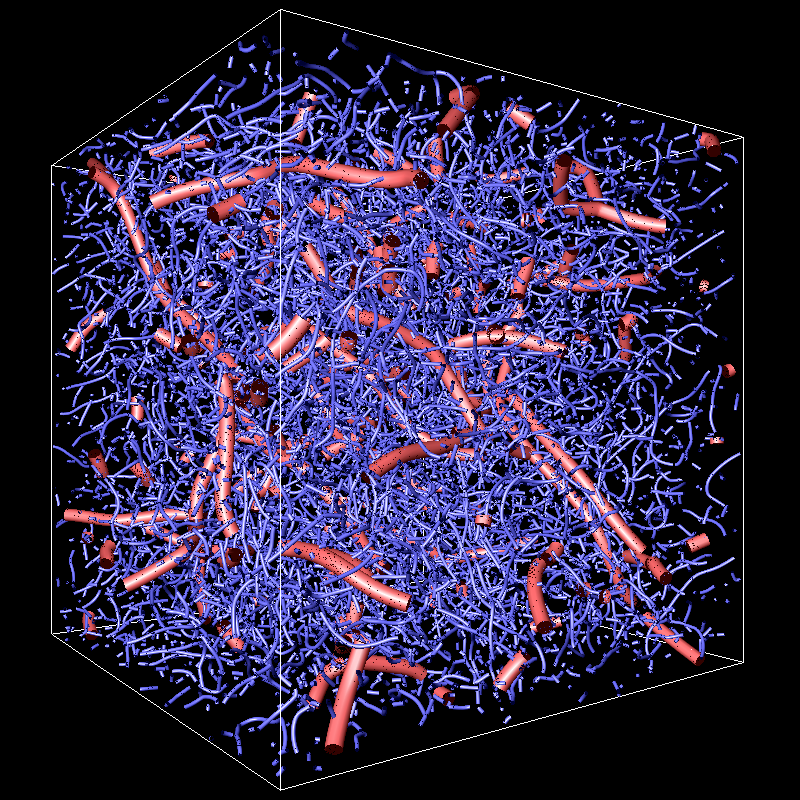Numerical Simulations of Fully Developed Turbulence
JAXA Supercomputer System Annual Report February 2021-January 2022
Report Number: R21EACA05
Subject Category: JSS Inter-University Research
- Responsible Representative: Susumu Goto, Professor, Osaka University
- Contact Information: Susumu Goto(s.goto.es@osaka-u.ac.jp)
- Members: Ryo Araki, Kento Eguchi, Yutaro Fujiki, Jun Fujino, Susumu Goto, Yusuke Koide, Satoshi Matsumoto, Daiki Watanabe
Abstract
Since fully developed turbulence at high Reynolds numbers plays an important role in many systems of aerospace engineering, its prediction and control are crucial in various projects. We need to employ a turbulence model so that we can effectively conduct numerical simulations of such extremely-high Reynolds-number flows. Here, we note that such a model is based on the universality of small-scale statistics of turbulence. The main purpose of the present study is to reveal the physical origin of this universality of turbulent flows. In particular, we aim at revealing details of the multi-scale motions (i.e. the hierarchy of coherent vortices and its sustaining mechanism) of different kinds of high-Reynolds-number turbulence under different boundary conditions by means of direct numerical simulations.
Reference URL
N/A
Reasons and benefits of using JAXA Supercomputer System
Turbulent flows are one of the most important research topics in the aerospace engineering. Direct numerical simulations of fully developed turbulence require supercomputers with sufficient amount of memories and storage. These are the reasons why we use JAXA supercomputer System.
Achievements of the Year
We have clarified the coherent vortical structures and their sustaining mechanism in developed turbulence of various kinds: namely, turbulence in a periodic cube, a turbulent boundary layer, turbulent channel flow, and the turbulent wake behind a cylinder. We have shown that turbulence is always composed of a hierarchy of vortex tubes with various length scales, and shear flow around larger-scale vortices amplify and create smaller-scale ones. This year, we conducted direct numerical simulations of high-Reynolds-number turbulence (Fig. 1) in a periodic cube to show that this vortex stretching process corresponds to the so-called energy cascade. The detailed analyses of the inter-scale energy transfer verify that it is indeed the case. In the inertial length scales, where the viscous and forcing effects are negligible, vortices at a given scale acquire their energy from the 1.7 times-larger vortices, and they transfer it to 1/1.7(=0.59) times-smaller ones.

Fig.1: The hierarchy of coherent vortex tubes in developed turbulence. The red and blue lines are the vortex axes at scales of 5L/8 and 5L/32, respectively. Here, L is the length scale of the external forcing.
Publications
– Peer-reviewed papers
1) Sunao Oka, Susumu Goto, Generalized sweep-stick mechanism of inertial-particle clustering in turbulence, Phys. Rev. Fluids 6 (2021) 044605.
2) Takeshi Matsumoto, Michio Otsuki, Takeshi Ooshida, Susumu Goto, Correlation function and linear response function of homogeneous isotropic turbulence in the Eulerian and Lagrangian coordinates, J. Fluid Mech. 919 (2021) A9.
3) Ryo Araki, Susumu Goto, Quasi-periodic fluctuations of von Karman turbulence driven by viscous stirring, Phys. Rev. Fluids 6 (2021) 084603.
4) Tsuyoshi Yoneda, Susumu Goto, Tomonori Tsuruhashi, Mathematical reformulation of the Kolmogorov-Richardson energy cascade in terms of vortex stretching, Nonlinearity, 35 (2022) 1380-1401.
5) Tomonori Tsuruhashi, Susumu Goto, Sunao Oka, Tsuyoshi Yoneda, Self-similar hierarchy of coherent tubular vortices in turbulence, Phil. Trans. Roy. Soc. A, (in press).
Usage of JSS
Computational Information
- Process Parallelization Methods: MPI
- Thread Parallelization Methods: OpenMP
- Number of Processes: 64 – 128
- Elapsed Time per Case: 30 Hour(s)
JSS3 Resources Used
Fraction of Usage in Total Resources*1(%): 0.04
Details
Please refer to System Configuration of JSS3 for the system configuration and major specifications of JSS3.
| System Name | CPU Resources Used(Core x Hours) | Fraction of Usage*2(%) |
|---|---|---|
| TOKI-SORA | 1029648.49 | 0.05 |
| TOKI-ST | 0.00 | 0.00 |
| TOKI-GP | 0.00 | 0.00 |
| TOKI-XM | 0.00 | 0.00 |
| TOKI-LM | 0.00 | 0.00 |
| TOKI-TST | 0.00 | 0.00 |
| TOKI-TGP | 0.00 | 0.00 |
| TOKI-TLM | 0.00 | 0.00 |
| File System Name | Storage Assigned(GiB) | Fraction of Usage*2(%) |
|---|---|---|
| /home | 2054.00 | 2.04 |
| /data and /data2 | 164040.00 | 1.75 |
| /ssd | 15760.00 | 4.07 |
| Archiver Name | Storage Used(TiB) | Fraction of Usage*2(%) |
|---|---|---|
| J-SPACE | 0.00 | 0.00 |
*1: Fraction of Usage in Total Resources: Weighted average of three resource types (Computing, File System, and Archiver).
*2: Fraction of Usage:Percentage of usage relative to each resource used in one year.
ISV Software Licenses Used
| ISV Software Licenses Used(Hours) | Fraction of Usage*2(%) | |
|---|---|---|
| ISV Software Licenses(Total) | 0.00 | 0.00 |
*2: Fraction of Usage:Percentage of usage relative to each resource used in one year.
JAXA Supercomputer System Annual Report February 2021-January 2022


